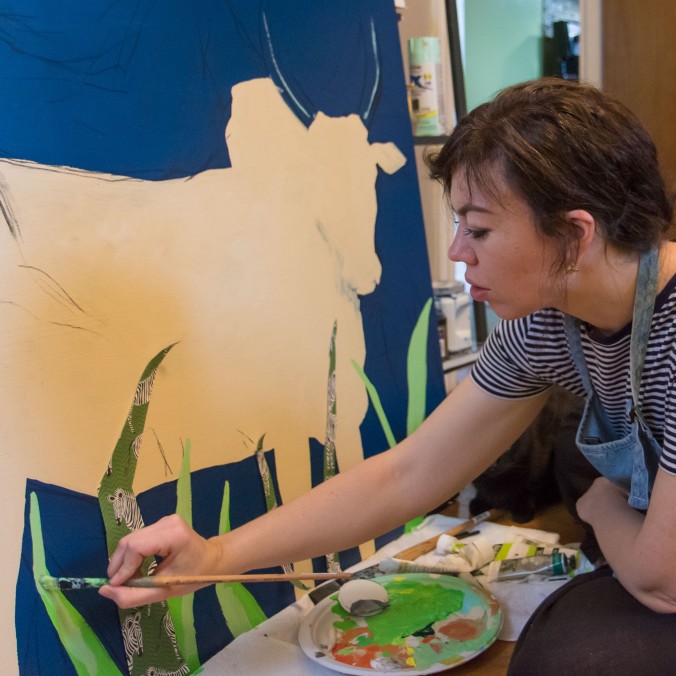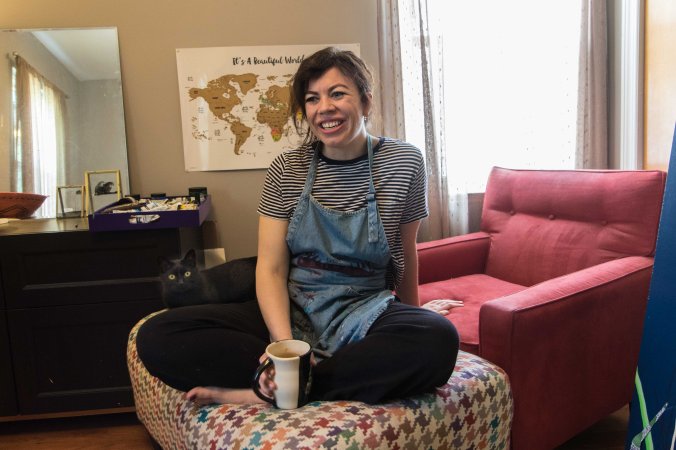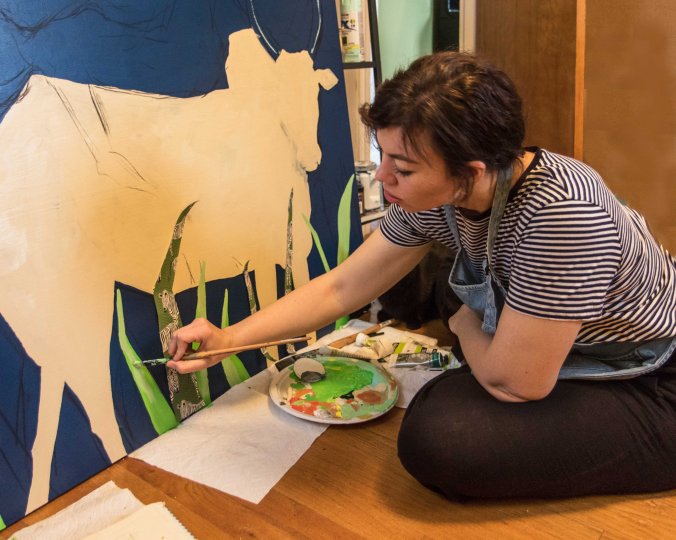
I first met artist Caitlin Cartwright at Dayton’s Front Street Buildings, on a night when more than three dozen studios and galleries were open to the public. Caitlin was the featured artist in the Color of Energy Gallery, and her vibrant painting-drawing-collages were creating quite a stir.
Caitlin explained that there was a narrative underlying each of her works, and I asked her to tell me a bit about some of them.

“Home is an intimate painting I did inspired by spending evenings in my backyard last Summer,” Caitlin explained. “The silhouetted figure behind the leaves is a symbol of myself, who was still coming to terms with domesticated life in my new home. There are small gold crickets in this painting that represent the sweetness of this same domestication and remind me of all the hours I listened to their sounds.”

“Float away is a reaction to my dad’s cancer diagnosis last year. I use this thin gold chain in a lot of my work as a symbol of a connection that’s precious but delicate. The birds on the silhouette of the person are also an image I use a lot. For me they are a symbol of hope and protection.”

“Monsters is a painting I made when I returned from India. I was inspired by the strength of many of the women I worked with, able to shield themselves against many obstacles or threats they may face and still grow and thrive. The painted face was a symbol of self protection. In reality a layer of paint won’t be able to do much but it’s a comfort and meaningful to the wearer.”

“Full Stop is about how life can be easily interrupted or change drastically without warning. I made this painting after moving back to Ohio and the Dayton skyline is what makes up the background.”
Before I left her exhibition I arranged to visit Caitlin in the studio in her home in Dayton’s Belmont neighborhood.
We entered the small bedroom that serves as Caitlin’s studio. I knew Caitlin had lived and worked in several countries, so before learning about her art process I asked about her travels.
“I grew up in the Dayton suburb of Centerville,” Caitlin told me. “As my interest in art grew I went to the School for Creative and Performing Arts in Cincinnati and then to MICA (Maryland Institute College of Art). After graduation I decided I wanted to experience a culture completely different from my own, and I managed to get a job in Madagascar.”

“In Madagascar I taught English for a year and in my spare time I did art projects with orphans and street kids. When I returned to the U.S. I applied to the Peace Corps. They sent me to Namibia in southwest Africa. There I helped start a girl’s afterschool club. One of our projects was gathering recycled materials to make baskets to sell.”
“When I returned to the U.S. I knew I wanted to pursue an advanced degree but I had trouble deciding on the field. I loved the community building I had done on my overseas trips but I also loved making my art. I felt torn between those two passions. I eventually decided to get a master’s degree in Sustainable International Development. Working on that degree put things into focus for me. I realized that if I used my art to build communities everything I loved fit together. There was no conflict.”

“A project I did as I worked on my masters degree was fascinating. I lived in Ahmedabad, India for four months documenting artisan’s stories. I went to their homes, sat with them and their families, and then photographed, filmed and wrote their stories. I put this information on a website that was available to anyone interested in buying their products.”

“Living and working in all of these places has been great for me as a visual artist All of the sights I’ve seen have been added to my visual vocabulary. You can see Madagascar in the piece I am just starting here.”
“For the last two years I have been the Education and Operations Manager of the Preble County Art Association. Now I see Preble County images are starting to work their way into my art.”
“I started this piece with a number of sketches. I usually do a combination of drawing and collage and paint, and the elements of the piece typically change a lot as I work. As I add and change elements I think about how each part of the piece contributes to the narrative. I want my art to work on two levels. I want it to be visually attractive and I want it to tell a story.”
With that, I left and let Caitlin return to working on her latest story.

